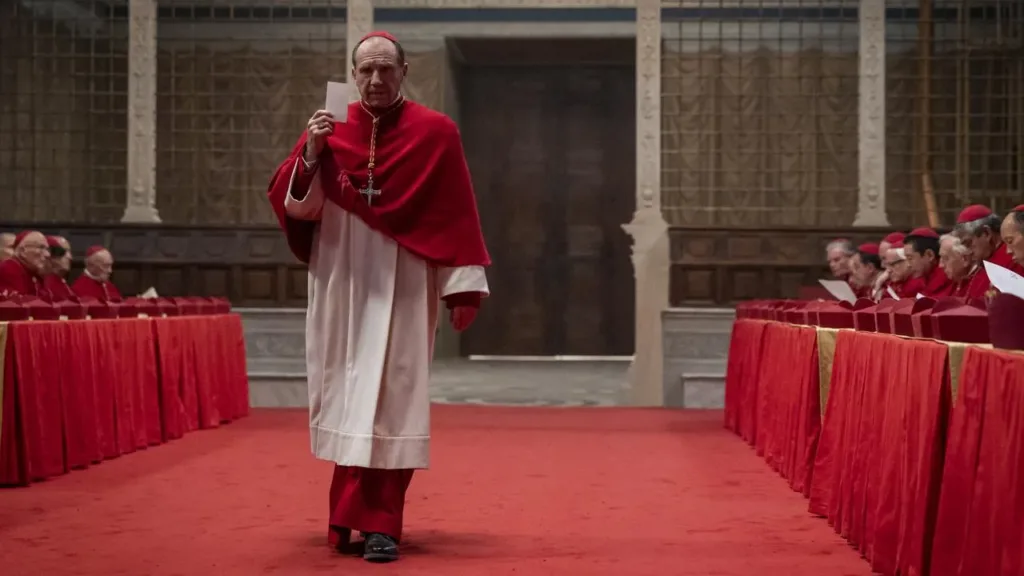Following the death of Pope Francis on Monday, two films centered on papal leadership saw sharp increases in U.S. streaming activity, according to data from entertainment metrics firm Luminate. The movies—Conclave, a dramatized account of a fictional papal election, and The Two Popes, a Netflix biographical drama—both experienced significant viewership gains between April 20 and 21.
Conclave, directed by Edward Berger and distributed by Focus Features, recorded a 283% increase in streaming minutes. Viewers in the U.S. logged 1.8 million minutes watched on April 20 and 6.9 million minutes on April 21. The film, based on a novel by Robert Harris, focuses on the election process that takes place after a pope’s death, with Ralph Fiennes portraying a key cardinal involved in the selection.
The film was recognized during awards season, winning the Oscar for Best Adapted Screenplay. Financed by FilmNation, Conclave earned more than $115 million globally on a production budget of $20 million.
Prior to Pope Francis’ death, the film had averaged 1.7 million minutes watched daily in the U.S. during the April 11–17 tracking week, placing the post-announcement jump well above its typical performance.
Netflix’s The Two Popes, released in 2019 and starring Jonathan Pryce as Pope Francis and Anthony Hopkins as Pope Benedict XVI, also saw a major spike in engagement. The film’s U.S. streaming minutes increased by 417%, from 290,000 on April 20 to 1.5 million on April 21. The movie explores the conversations and ideological contrasts between the two pontiffs during a period of transition in the Catholic Church. It received three Academy Award nominations, including Best Actor for Pryce, Best Supporting Actor for Hopkins, and Adapted Screenplay for Anthony McCarten.
As the Vatican prepares to convene the College of Cardinals for the real-life conclave that will select a new pope, commentary surrounding the accuracy of cinematic portrayals has resurfaced. Conclave, while praised for its design and performances, has drawn criticism from some Church insiders over its depiction of internal politics and intrigue.
Cardinal Sean O’Malley, who participated in the 2013 conclave that elected Pope Francis, dismissed depictions of power struggles. Writing in February, he noted, “The business of electing a pope is not some sort of scene of political backroom plotting.” He emphasized the focus among participants on spiritual reflection and global responsibility during the process.
The conclave, expected to begin between May 6 and May 11 following the funeral of Pope Francis, remains one of the most confidential proceedings in the Church. The term itself comes from the Latin cum clave, meaning “with a key,” referring to the tradition of secluding cardinals until a decision is reached. Voting takes place inside the Sistine Chapel, and participants are prohibited from outside communication.
While cardinals are expected to uphold secrecy, limited details often emerge. In a 2023 interview, Francis acknowledged that he had been the focus of a failed attempt to block Cardinal Joseph Ratzinger’s path to election in 2005. Francis said he declined to participate in the maneuver and instead voted for Ratzinger, who became Pope Benedict XVI.
In that same interview, he mentioned that popes often speak about past conclaves even when cardinals are expected not to, saying, “Cardinals swear not to reveal what happens in the conclave, but popes have a licence to tell it.”
Author Robert Harris has said his approach to the Conclave novel and film adaptation was secular, grounded in curiosity about how powerful institutions manage succession. “They have to stay there for days until they get a two-thirds majority,” he told The Boston Globe, describing the premise as inherently dramatic.
Berger, the film’s director, told Reuters last fall that the Vatican setting served as a backdrop for broader observations on competition for leadership roles. “Whenever that power vacuum exists, there’s going to be people striving for it,” he said.
Reactions to the film have varied. The Italian bishops’ newspaper Avvenire praised the production values but questioned certain characterizations, noting that Italian viewers may interpret parts of the film as exaggerated.
Streaming increases for Conclave and The Two Popes reflect public interest in portrayals of ecclesiastical decision-making as the Church prepares for its next chapter.
